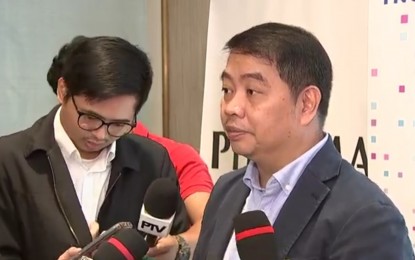
LOWER MILLING LOSSES. Assistant Secretary Arnel de Mesa says the Department of Agriculture aims to lower milling losses in rice to at least five to 10 percent, from the current 15 percent to 20 percent, during an ambush interview on Monday (June 24, 2024). He said the DA is also seeking a higher budget for farm-to-market roads and post-harvest facilities to realize the administration's food security targets. (Screengrab)
MANILA – The private sector can help the country realize its food security targets under the administration of President Ferdinand R. Marcos Jr. through agro-industries investments, according to the Department of Agriculture (DA).
During the PHINMA Corporation, Stratbase ADR Institute and Makati Business Club, Inc. policy forum on Monday, DA Assistant Secretary Arnel de Mesa underscored the need for more support from the private sector, citing key areas like economies of scale through farm consolidations.
"We want the private sector to help us in our clustering and consolidation. If you look at Thailand, and Vietnam for example, their minimum farm size to be very efficient is about a hundred hectares for rice and corn," he said.
He noted that most Filipino farmers till an average farm size of about one to two hectares.
This makes everything expensive for farmers, from farm inputs cost to mechanization, not to mention the lower efficiency, De Mesa said.
"We can bring down the cost of inputs. We can make our machinery and mechanization more efficient if we have economies of scale... We need to start now in making sure that our farms will become very efficient," he added.
Meanwhile, De Mesa said the DA is looking at ways to lower average milling losses in rice to at least five percent to 10 percent.
The current milling losses range from 15 percent to 20 percent, which is equivalent to 342,000 metric tons per year.
"We need to increase iyong ating milling efficiency. So that mas marami iyong buo, iyong tinatawag na head rice… target mapababa siya (there's more of what they call head rice... we're targeting to lower it to) at least 5 to 10 percent, and then eventually, mabawasan pa lalo sa mga susunod na taon (lower it even more in the succeeding years)," he said in an interview.
Besides investing in newer and more efficient rice mills, he said one of the solutions being considered to increase milling efficiency was lessening the varieties of rice per region.
He pointed out that there are many rice varieties -- long, round, small and large -- which, when milled together, will produce more broken rice.
“Kapag mas marami iyong broken, lugi dun iyong farmer, mas magiging mababa iyong presyo (If there's more broken, farmers will have lower income because of the cheaper price)," De Mesa said.
He said they are also requesting for a higher budget for the improvement of drying, milling and post-harvest facilities to further trim down production losses.
For 2025, the DA is proposing around PHP13.1 billion for its post-harvest related machinery, equipment, and facilities, much higher than this year's PHP4.2 billion.
It is also seeking to increase its budget for farm-to-market road projects amounting to PHP50 billion and over PHP200 billion for irrigation. (PNA)
